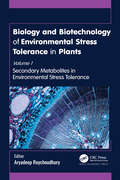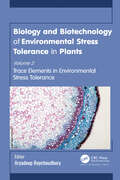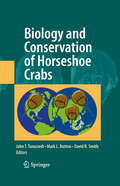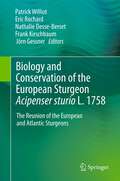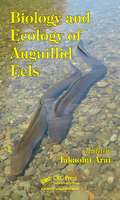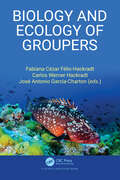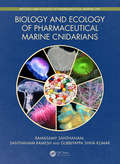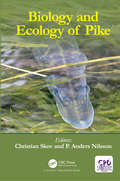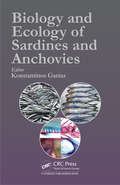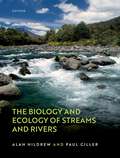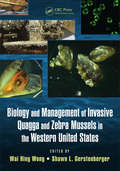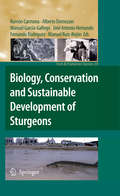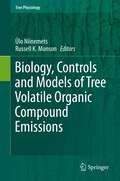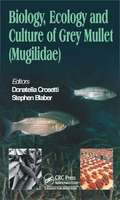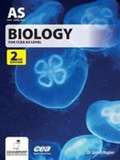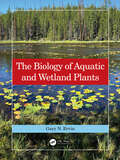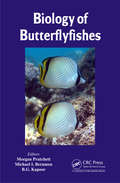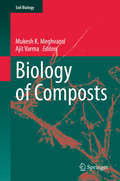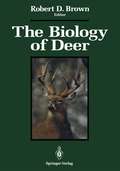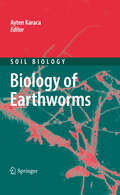- Table View
- List View
Biology and Biotechnology of Environmental Stress Tolerance in Plants: Volume 1: Secondary Metabolites in Environmental Stress Tolerance
Abiotic stresses such as drought, high salt, cold, heat, UV radiation, heavy metal pollution, etc., are increasingly responsible for restricting plant growth and agricultural production and are becoming more alarming due to threats from global climate change. To combat these threats, this new 3-volume set provides a comprehensive understanding of the mechanisms that mediate biosynthesis, accumulation, and degradation of plant metabolites to improve crop production and enhance abiotic stress tolerance in plants. Volume 1: Secondary Metabolites in Environmental Stress Tolerance focuses exclusively on the diverse secondary metabolites that play a major role in the adaptation of plants to the environment and in overcoming stress conditions as well as their implications for enhancing tolerance mechanisms. The book presents available information on the protective roles rendered by a wide array of antioxidative secondary metabolites and their regulation during diverse environmental stress. Volume 2: Trace Elements in Environmental Stress Tolerance throws light on the different inorganic trace elements, including metal nanoparticles, that help to deal with environmental stresses. While these elements at high level create considerable phytotoxicity and halt metabolic and enzymatic activity, they also promote growth and development in limited quantity, so that they have significant potential in revamping plant morphology and physiology under stressed conditions. Hence, optimum concentration management of these elements can help to mitigate world hunger and contribute toward sustainable agriculture and food security under challenging environments. Volume 3: Sustainable Approaches for Enhancing Environmental Stress Tolerance focuses on the agronomic and biochemical approaches as well as biotechnological and high-throughput technologies, including the prospects of genetic engineering, epigenetics and the latest CRISPR/Cas technology, in generating stress-tolerant plants. The volume provides a clear roadmap for the implementation of techniques for improving abiotic stress tolerance in plants for better sustenance.
Biology and Biotechnology of Environmental Stress Tolerance in Plants: Volume 2: Trace Elements in Environmental Stress Tolerance
Abiotic stresses such as drought, high salt, cold, heat, UV radiation, heavy metal pollution, etc., are increasingly responsible for restricting plant growth and agricultural production and are becoming more alarming due to threats from global climate change. To combat these threats, this new 3-volume set provides a comprehensive understanding of the mechanisms that mediate biosynthesis, accumulation, and degradation of plant metabolites to improve crop production and enhance abiotic stress tolerance in plants. Volume 1: Secondary Metabolites in Environmental Stress Tolerance focuses exclusively on the diverse secondary metabolites that play a major role in the adaptation of plants to the environment and in overcoming stress conditions as well as their implications in enhancing tolerance mechanisms. The book presents information on the protective roles rendered by a wide array of antioxidative secondary metabolites and their regulation during diverse environmental stress. Volume 2: Trace Elements in Environmental Stress Tolerance throws light on the different inorganic trace elements, including metal nanoparticles, that help to deal with various environmental stresses. While these elements at high level create considerable phytotoxicity and halt metabolic and enzymatic activity, they also promote growth and development in limited quantity, so that they have significant potential in revamping plant morphology and physiology under stressed conditions. Hence, optimum concentration management of these elements can help to mitigate world hunger and contribute toward sustainable agriculture and food security under challenging environments. Volume 3: Sustainable Approaches for Enhancing Environmental Stress Tolerance focuses on agronomic and biochemical approaches as well as biotechnological and high-throughput technologies, including the prospects of genetic engineering, epigenetics and the latest CRISPR/Cas technology in generating stress-tolerant plants. The volume provides a clear roadmap for the implementation of techniques for improving abiotic stress tolerance in plants for better sustenance.
Biology and Conservation of Horseshoe Crabs
by David Smith Mark L. Botton John T. TanacrediHorseshoe crabs, those mysterious ancient mariners, lured me into the sea as a child along the beaches of New Jersey. Drawn to their shiny domed shells and spiked tails, I could not resist picking them up, turning them over and watching the wondrous mechanical movement of their glistening legs, articulating with one another as smoothly as the inner working of a clock. What was it like to be a horseshoe crab, I wondered? What did they eat? Did they always move around together? Why were some so large and others much smaller? How old were they, anyway? What must it feel like to live underwater? What else was out there, down there, in the cool, green depths that gave rise to such intriguing creatures? The only way to find out, I reasoned, would be to go into the ocean and see for myself, and so I did, and more than 60 years later, I still do.
Biology and Conservation of the European Sturgeon Acipenser sturio L. 1758: The Reunion of the European and Atlantic Sturgeons
by Patrick Williot, Eric Rochard, Nathalie Desse-Berset, Frank Kirschbaum and Jörn GessnerThe book aims at synthesizing our current knowledge of Acipenser sturio and its management. This species, one of the most widespread sturgeon species all over Western Europe ranging from the Black Sea to the Baltic, is now on the verge of extinction. Major aspects of its biology and management, including mismanagement, are provided in a historic perspective. Similarly, the changes in the restoration programs (in situ and ex situ) initiated in France and Germany are presented. As the species occurred in sympatry with Acipenser oxyrinchus in Germany and Poland and very recently in France as well, a brief outlook on restoration-management programs of A. oxyrinchus are also provided for both North America and Northern European countries, namely Germany and Poland. As conservation-restoration actions go beyond scientific issues, non-governmental stakeholders and marine professional fishermen’s organizations have also been asked to contribute, and the key role of a French-German cooperation plan is underlined. A part of the book is devoted to perspectives. Illustrations of the European sturgeon, mainly in photographs, but also in stamps and paintings, are presented.
Biology and Ecology of Anguillid Eels
by Takaomi AraiAnguillid eels have fascinated biologists for centuries due to their spectacular long-distance migrations between freshwater habitats and their spawning areas far out in the ocean. This book provides a long overdue update on the biology and ecology of anguillid eels and features comprehensive coverage of the key features of the genus Anguilla. It c
Biology and Ecology of Groupers
by Fabiana Cézar Félix-HackradtGroupers are fascinating charismatic fishes commonly found in reef habitats around the world that sustain a global multimillionaire fishery. They are an important top predator species and therefore of paramount ecological importance for reef systems' resilience. The book, Biology and Ecology of Groupers is an up-to-date review of the main bio-ecological topics involving worldwide groupers species oriented to the academic community and managers. It covers aspects of classification and phylogenetic relationships, geographical distribution, and life history related characteristics (Section I), including the major threats of groupers populations, case studies of successful management and comments about the future of groupers in our changing world (Section II).
Biology and Ecology of Groupers
by Fabiana Cézar Félix-Hackradt Carlos Werner Hackradt José Antonio García-ChartonGroupers are fascinating charismatic fishes commonly found in reef habitats around the world that sustain a global multimillionaire fishery. They are an important top predator species and therefore of paramount ecological importance for reef systems' resilience. The book, Biology and Ecology of Groupers is an up-to-date review of the main bio-ecological topics involving worldwide groupers species oriented to the academic community and managers. It covers aspects of classification and phylogenetic relationships, geographical distribution, and life history related characteristics (Section I), including the major threats of groupers populations, case studies of successful management and comments about the future of groupers in our changing world (Section II).
Biology and Ecology of Pharmaceutical Marine Cnidarians (Biology and Ecology of Marine Life)
by Ramasamy Santhanam Santhanam Ramesh Gubbiyappa Shiva KumarThe first comprehensive book on the biology and ecology of pharmaceutical cnidarians, answering a need for more knowledge about the identification, biology, natural products and bioactivities of these living resources. Contributed by scientists of both marine biology and pharmacy disciplines. Identifies the correct marine species, shows the ecological parameters of that species, and explores its biological values with particular attention to primary and secondary metabolites or bioactive constituents. A useful supplementary text on Marine Biology and Pharmacology courses. Nearly 200 illustrations are produced in full color, providing a high-quality reference. This book provides the taxonomy, common name, global distribution, habitat, diagnostic features, and pharmaceutical compounds (along with their activities) of 200 species of marine cnidarians along with nearly 200 detailed illustrations in glorious color. The phylum Cnidaria (formerly Coelenterata) is a large, diverse, and ecologically important group of marine invertebrates which make up 40 percent of the biomass of the oceans. Marine invertebrates are the richest source of marine natural products with potential applications in the pharmaceutical and medical sectors, and it has been reported that over 3000 bioactive compounds have been described from this phylum alone, mostly in the last decade.
Biology and Ecology of Pharmaceutical Marine Cnidarians (Biology and Ecology of Marine Life)
by Ramasamy Santhanam Santhanam Ramesh Gubbiyappa Shiva KumarThe first comprehensive book on the biology and ecology of pharmaceutical cnidarians, answering a need for more knowledge about the identification, biology, natural products and bioactivities of these living resources. Contributed by scientists of both marine biology and pharmacy disciplines. Identifies the correct marine species, shows the ecological parameters of that species, and explores its biological values with particular attention to primary and secondary metabolites or bioactive constituents. A useful supplementary text on Marine Biology and Pharmacology courses. Nearly 200 illustrations are produced in full color, providing a high-quality reference. This book provides the taxonomy, common name, global distribution, habitat, diagnostic features, and pharmaceutical compounds (along with their activities) of 200 species of marine cnidarians along with nearly 200 detailed illustrations in glorious color. The phylum Cnidaria (formerly Coelenterata) is a large, diverse, and ecologically important group of marine invertebrates which make up 40 percent of the biomass of the oceans. Marine invertebrates are the richest source of marine natural products with potential applications in the pharmaceutical and medical sectors, and it has been reported that over 3000 bioactive compounds have been described from this phylum alone, mostly in the last decade.
Biology and Ecology of Pike
by Anders Nilsson P. Anders NilssonThis book sets out to bridge the order scales among pike researchers, populations, communities, management, and fisheries. It emphasizes the progress of pike research during the last two decades, during which the order-bridging approach emerged. This framework underpins the text and the message, to convey its importance to pike research and to fish research in general. In addition, a considerable part of the book is devoted to management implications and highlights aspects of human dimensions in recreational fisheries.
Biology and Ecology of Pike
by Christian Skov P. Anders NilssonThis book sets out to bridge the order scales among pike researchers, populations, communities, management, and fisheries. It emphasizes the progress of pike research during the last two decades, during which the order-bridging approach emerged. This framework underpins the text and the message, to convey its importance to pike research and to fish research in general. In addition, a considerable part of the book is devoted to management implications and highlights aspects of human dimensions in recreational fisheries.
Biology and Ecology of Sardines and Anchovies
by Konstantinos GaniasApart from being commercially and socially significant, anchovies and sardines populations occupy crucial positions in the oceans' ecosystems. Low in the food chain, clupeoids tend towards abundance, as if their purpose in life was to be eaten and fuel the upper levels of marine trophic chains. The present book covers a broad spectrum of topics on
The Biology and Ecology of Streams and Rivers
by Alan Hildrew Paul GillerThe challenges that the world's running water systems now face have never been more numerous or acute; at the same time, these complex habitats remain absolutely crucial to human wellbeing and future survival. If rivers can ever be anything like sustainable, ecology needs to take its place as an equal among the physical sciences such as hydrology and geomorphology. A real understanding of the natural history and ecology of running waters must now be brought even more prominently into river management. The primary purpose of this textbook is to provide the up-to-date overview that students and practitioners will require to achieve this aim. The book's unifying focus is on rivers and streams as ecosystems in which the particular identity of organisms is not the main emphasis but rather the processes in which they are involved - specifically energy flow and the cycling of materials. It builds on the physicochemical foundations of the habitat templet and explores the diversity and adaptations of the biota, progressing from the population and community ecology of organisms and linking them to ecosystem processes and services in the wider biosphere via the complexities of species interactions and food webs. These include water quality and patterns of river discharge, as well as aesthetics, waste disposal, and environmental health. While the book is not primarily focused on application per se, each chapter addresses how humans affect rivers and, in turn, are affected by them. A final, future-oriented chapter identifies key strategic areas and sets a roadmap for integrating knowledge of natural history and ecology into policy and management. The Biology and Ecology of Streams and Rivers is an accessible text suitable for both senior undergraduate and graduate students taking courses in both lotic and general ecology as well as more established researchers, practitioners, managers, and conservationists requiring a concise and contemporary overview of running waters.
Biology and Management of Invasive Quagga and Zebra Mussels in the Western United States
by Wai Hing Wong Shawn L. GerstenbergerBiology and Management of Invasive Quagga and Zebra Mussels in the Western United States is a synthesis of the biology and management of invasive mussels from scientists and managers working on invasive quagga and zebra mussels in the western United States. Invasive dreissenid mussels have spread throughout southwestern United States at unprecedent
Biology, Conservation and Sustainable Development of Sturgeons (Fish & Fisheries Series #29)
by Ramón Carmona José Antonio Hernando Fernando Rodríguez Manuel Ruiz-Rejón Alberto Domezain Manuel García GallegoSturgeons are considered “living fossils”, sharing many morphological and biological features with ancestral fish. Furthermore, sturgeons are of the utmost interest from an economic perspective, not only for the caviar but for the flesh. However, the wild populations of the majority of the species are at serious risk of extinction all over the world. So, it is urgent to develop strategies for both farming culture and conservation and recovery in natural habitats. This book provides a comprehensive view of the biology and sustainable development of sturgeons putting emphasis on the Southern Europe autochthonous species such as Acipenser nacarii and Acipenser sturio that share geographical distribution. Other relevant species (such as Huso huso, A. oxyrhinchus, A. ruthenus, A. stellatus) and areas (Germany, Russia, North America) are also considered. The contents are organised in three sections: Taxonomy and Biogeography (including the morphological and genetic analyses that clarify the taxonomy and phylogeny of sturgeons, focused on those from Southern Europe), Biology and Aquaculture (where several aspects of the developmental biology, feeding, and reproduction are considered in relation to the improvement of sturgeon farming), and Recovery and Conservation (that collates and analyses different recovery research actions, the ecology of the rivers for restoration as well as the problems related to the trade of caviar).
Biology, Controls and Models of Tree Volatile Organic Compound Emissions (Tree Physiology #5)
by Ülo Niinemets and Russell K. MonsonPlant-driven volatile organic compound (BVOC) emissions play a major role in atmospheric chemistry, including ozone and photochemical smog formation in the troposphere, and they extend the atmospheric lifetime of the key greenhouse gas, methane. Furthermore, condensation of photo-oxidation products of BVOCs leads to formation of secondary organic aerosols with profound implications for the earth's solar radiation budget and climate. Trees represent the plant life form that most contributes to BVOC emissions, which gives global forests a unique role in regulating atmospheric chemistry.Written by leading experts in the field, the focus is on recent advancements in understanding the controls on plant-driven BVOC emissions, including efforts to quantitatively predict emissions using computer models, particularly on elicitation of emissions under biotic and abiotic stresses, molecular mechanisms of volatile synthesis and emission and the role of emissions in plant stress tolerance.
Biology, Ecology and Culture of Grey Mullets (Mugilidae)
by Donatella Crosetti Stephen J. M. BlaberMullets (grey mullets) are a family (Mugilidae) and order of ray-finned fish found in temperate and tropical waters worldwide. There are approximately 80 species of mullet; these fish have been considered an important food source in Mediterranean Europe since Roman times. This book provides a long overdue update on the biology and ecology of mullet
Biology for CCEA AS Level (PDF)
by James NapierFully updated for the revised CCEA specification (first teaching September 2016) and endorsed by CCEA. It has been subject to a detailed quality assurance process by an independent Biology expert. It contains new colour-coded practical work sections to address the AS3 paper and provides sample examination questions for each topic. Illustrated in full colour with bright and clear presentation. The author, Dr James Napier, is a well-known Biology author who, prior to his recent retirement, was vice-principal in a Northern Ireland grammar school.
Biology Now! 11-14 2nd Edition Pupil's Book (PDF)
by Peter RileyBiology Now! 11-14 is one of three Pupil's Books that cover the requirements of the National Curriculum for science at Key Stage 3, the Common Entrance Examination at 13+ syllabus and equivalent junior science courses. Based on Biology Now! 11-14, the clear text and colourful illustrations and photographs fully explain the concepts and encourage background reading. Boxed sections are used to show how scientific ideas have developed and how they are applied in today's world. Throughout there are numerous questions that test a range of skills including comprehension, application, analysis and evaluation. These may be used as a basis for classwork or homework. There are also 'For discussion' sections to encourage group discussion. In this second edition the Chapters have been reorganised to reflect the QCA Scheme of Work. There is also additional information on types of tissue, parental care in different organisms, daily adaptations in plants and animals and a new chapter on Plants for Food. Each book has a glossary and is supported by a Teacher's Resource Book that contains details of practical work.
The Biology of Aquatic and Wetland Plants
by Gary N. ErvinAquatic plants play a critically important role in maintaining ecosystem health. They are natural biological filters in freshwater and estuarine wetlands; they contribute to the reproductive success of many organisms, some of which are harvested for food; they assist in flood control; and they are prominent elements in the aesthetics and recreational use of freshwater and estuarine habitats. Despite this globally recognized importance, wetlands have faced and continue to face threats from the encroachment of human activities. The Biology of Aquatic and Wetland Plants is a thorough and up-to-date textbook devoted to these plants and their interactions with the environment. The focus is on botanical diversity from the perspective of evolutionary relationships, emphasizing the role of evolution in shaping adaptations to the aquatic environment. By incorporating recent findings on the phylogeny of green plants, with special emphasis on the angiosperms, the text is broadly useful for courses in plant biology, physiology, and ecology. Additionally, a chapter on population biology and evolutionary ecology complements the evolutionary backdrop of hydrophyte biology by examining the details of speciation and applications of modern genetic approaches to aquatic plant conservation. Key Features • Synthesizes recent and seminal literature on aquatic and wetland plants • Emphasizes evolutionary history as a factor influencing adaptations to the wetland environment • Provides a global perspective on plant diversity and threats facing wetland ecosystems • Highlights research needs in the field of aquatic and wetland plant biology • Includes 280 figures, with more than 300 color photographs, and 41 tables to provide ease of access to important concepts and information
The Biology of Aquatic and Wetland Plants
by Gary N. ErvinAquatic plants play a critically important role in maintaining ecosystem health. They are natural biological filters in freshwater and estuarine wetlands; they contribute to the reproductive success of many organisms, some of which are harvested for food; they assist in flood control; and they are prominent elements in the aesthetics and recreational use of freshwater and estuarine habitats. Despite this globally recognized importance, wetlands have faced and continue to face threats from the encroachment of human activities. The Biology of Aquatic and Wetland Plants is a thorough and up-to-date textbook devoted to these plants and their interactions with the environment. The focus is on botanical diversity from the perspective of evolutionary relationships, emphasizing the role of evolution in shaping adaptations to the aquatic environment. By incorporating recent findings on the phylogeny of green plants, with special emphasis on the angiosperms, the text is broadly useful for courses in plant biology, physiology, and ecology. Additionally, a chapter on population biology and evolutionary ecology complements the evolutionary backdrop of hydrophyte biology by examining the details of speciation and applications of modern genetic approaches to aquatic plant conservation. Key Features • Synthesizes recent and seminal literature on aquatic and wetland plants • Emphasizes evolutionary history as a factor influencing adaptations to the wetland environment • Provides a global perspective on plant diversity and threats facing wetland ecosystems • Highlights research needs in the field of aquatic and wetland plant biology • Includes 280 figures, with more than 300 color photographs, and 41 tables to provide ease of access to important concepts and information
Biology of Butterflyfishes
by Morgan S. Pratchett Michael L. Berumen B. G. KapoorButterflyfishes (family Chaetodontidae) are a highly conspicuous component of fish fauna on coral reefs throughout the world. In light of their strong dependence on coral, they are often regarded as the epitome of coral reef fishes. This volume examines the ecology and conservation of coral reef butterflyfishes. It provides important insights on th
Biology of Composts (Soil Biology #58)
by Mukesh K. Meghvansi Ajit VarmaThis book highlights the latest findings on fundamental aspects of composting, the interaction of various microorganisms, and the underlying mechanisms. In addition to addressing modern tools and techniques used for composting research, it provides an overview of potential composting applications in both agriculture and environmental reclamation.Composting is the process of organic waste decomposition, mediated by microorganisms. The end-product is called ‘compost’ and can be used as a supplement to improve soil fertility. As the municipal waste generated in most developing countries contains a substantial amount of organic matter suitable for composting, this technology offers a win-win opportunity for stakeholders in terms of disposing of organic waste and providing organic fertilizers for agriculture. In addition, using compost reduces the dependency on harmful chemical fertilizers, and represents a sustainable and environmentally friendly alternative.
The Biology of Deer
by Robert D. BrownThe first International Conference on the Biology of Deer Production was held at Dunedin, New Zealand in 1983. That meeting provided, for the first time, a forum for those with interests in either wild deer management or farmed deer production to come together. Scientists, wild deer managers, domestic deer farmers, veterinarians, venison and antler product producers, and others were able to discuss common problems and to share their knowledge and experience. The relationships formed at that meeting, and the information amassed in the resulting Proceedings, sparked new endeavors in cervid research, management, and production. A great deal has taken place in the world of deer biology since 1983. Wild deer populations, although ever increasing in many areas of the world, face new hazards of habitat loss, environmental contamination, and overexploitation. Some species are closer to extinction than ever. Game managers often face political as well as biological challenges. Many more deer are now on farms, leading to greater concerns about disease control and increased needs for husbandry information. Researchers have accumulated considerable new in formation, some of it in areas such as biochemical genetics, not discussed in 1983.
Biology of Earthworms (Soil Biology #24)
by Ayten KaracaEarthworms, which belong to the order Oligochaeta, comprise roughly 3,000 species grouped into five families. Earthworms have been called ‘ecosystem engineers’; much like human engineers, they change the structure of their environments. Earthworms are very versatile and are found in nearly all terrestrial ecosystems. They play an important role in forest and agricultural ecosystems. This Soil Biology volume describes the various facets of earthworms, such as their role in soil improvement, soil structure, and the biocontrol of soil-borne plant fungal diseases. Reviews discuss earthworms’ innate immune system, molecular markers to address various issues of earthworm ecology, earthworm population dynamics, and the influences of organic farming systems and tillage. Further topics include the characteristics of vermicompost, relationships between soil earthworms and enzymes, the role of spermathecae, copulatory behavior, and adjustment of the donated sperm volume.
